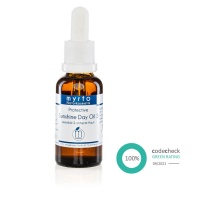In this article we explain the benefits and possible dangers of sunscreens with nanoparticles for health and our environment. You will find out whether nanoparticles are also permitted in certified natural cosmetics and whether a sunscreen with 49% nanoparticles is considered "non-nano" according to the current EU definition.
What are nanoparticles in sunscreens?
Nanoparticles (from ancient Greek: nanos = dwarf) are extremely small particles whose size is between 1 and 100 nanometers. Mineral sunscreens often contain nanoparticles made of zinc oxide (ZnO) and titanium dioxide (TiO₂). Mineral particles reflect UV rays directly before they can penetrate the skin. They offer broad-spectrum protection and do not break down under solar radiation, so they are photostable.
Chemical UV filters such as avobenzone, oxybenzone, octocrylene or ethylhexyl methoxycinnamate can also be used in nano size to increase their stability and effectiveness and improve absorption through the skin.
What advantages do nanoparticles offer?
- Cosmetic properties
Since mineral nanoparticles are significantly smaller, they have an almost transparent appearance when applied and do not leave any visible white residue on the skin, as is the case with larger particles. While larger mineral particles seal the skin more or less and make it difficult for the skin to sweat, the skin feels much lighter and more pleasant with creams containing nanoparticles. - Stability:
Nanoparticles are distributed better in a sunscreen than larger particles. They are less likely to settle and stabilize the texture of a cream.
What are potential dangers of nanoparticles in sunscreens?
- Long-term health effects
There are repeated warnings that nanoparticles can penetrate the body through the skin and have toxic effects there. In animal experiments, researchers have observed that nanoparticles can cause inflammation, organ damage and tumors in the bodies of mice and rats (E. J. Evans, et al., "Titanium dioxide nanoparticles: a review of current toxicological data," Journal of Applied Toxicology, 2019). However, the study situation is not yet clear. Many experts consider the risk to be low as long as the skin barrier is intact.
The situation is different for irritated skin after sunburn, for sensitive and delicate baby or child skin, for acne, neurodermatitis or rosacea. There is currently no data on possible long-term consequences if nanoparticles are deposited in organs or the lymphatic system in the human body. Long-term consequences when nanoparticles penetrate body cells include possible damage to DNA (mutagenicity, genotoxicity), but also the likelihood of causing cancer (carcinogenicity). - Environmental pollution
Nanoparticles can enter the environment via sunscreens when bathing, settle and damage aquatic ecosystems such as coral reefs. According to EU chemicals law (REACH), nano-zinc oxide must not enter the environment; it is considered to be very toxic to aquatic organisms, with acute and long-term effects (water hazard class 2, hazard phrase H 410). These include harmful effects of zinc oxide nanoparticles such as immobilization in fish (rainbow trout), daphnia (crustaceans) and other small aquatic creatures.
Nanoparticles in sunscreens and the 50% rule
Sunscreens and natural cosmetic sunscreens can contain nanoparticles. If the nanoparticle content is more than 50% of the total UV filter particles used, this must be declared as "nano" according to the EU definition of nanomaterials. However, if the proportion of mineral or chemical nanoparticles is less than 50%, the product does not have to be declared as "nano" (see Official Journal of the European Union, Recommendation for a Definition of Nanomaterials of October 18, 2011, revised on June 10, 2022). As a result, a sunscreen that contains, for example, 49% mineral nano particles is not labelled as "nano".
UV filters and the body's own vitamin D production
Chemical and mineral UV sunscreen filters hinder the body's own production of vitamin D. This vitamin, in its active form calcitriol, supports the incorporation of calcium into our bone tissue, has a significant influence on the function of the thyroid gland and strengthens our immune system. Even a chemical or mineral SPF 20 blocks 95 - 99% of the body's own vitamin D production. A deficiency in this vital vitamin is one of the biggest health problems of our time. Studies show that vitamin D not only improves our protection against colds and depression, but also against diabetes, colon cancer, osteoporosis and heart attacks.
Conclusion
Mineral nanoparticles in sunscreens offer effective protection against UV rays and improve the cosmetic properties of a cream when applied to the skin. However, we believe that the potential health and environmental risks of nanoparticles in UV filters must be taken into account in order to ensure long-term safety.
We therefore recommend the myrto Sunshine Day Oil with 100% plant-based sun protection for daily use on the face.





